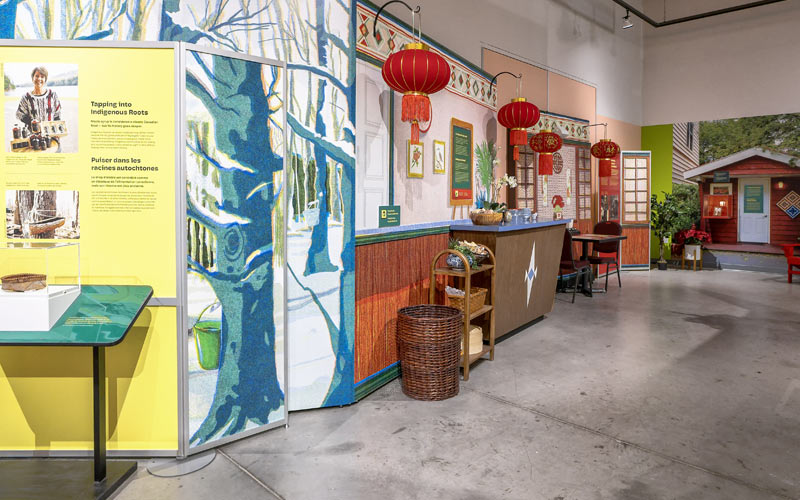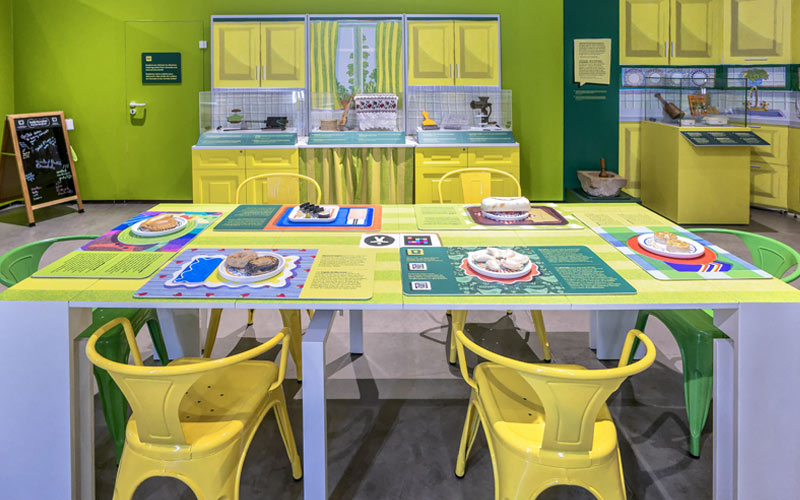By Steven Schwinghamer, Historian
Introduction
They took me to Woolco—which doesn’t exist now. Woolco was Scotia Square’s last department store. And we bought pots and pans. Since she realized I hadn’t cooked before, we bought a cookbook called The I Never Cooked Before Cookbook. I still have it…it tells you how to break an egg and separate the yolk from the white, how to tell when an egg’s hard boiled or soft boiled. It’s very good. Anyway, so, I bought an umbrella because I didn’t have an umbrella. And some basic things like that, and that was it. I did not know how to cook, even though I had a cookbook. So I had little money that they’d given me—an advance. So I went across the street and bought a TV dinner, which I stuck in the oven. And it wasn’t very tasty. When she found out, she says, “You can’t afford to buy that stuff. It’s too expensive. You’re going to have to learn how to cook.” So I started cooking, making things like meatloaf or shepherd’s pie.[1]
Ugandan Asian refugee Mario DeMello came to Canada in 1972, leaving his home after the exclusion edict of dictator Idi Amin. His early introduction to Canadian life included the absolute necessity of adapting to new foods and cooking habits (including cooking for himself). DeMello’s story signals the interweaving of migration and foodways in Canadian history, the theme at the heart of the Canadian Museum of Immigration temporary exhibition eat make share: a taste of immigration. One section of the exhibit engages with the history and hybridity of food in Canada through recipes and cookbooks. Cookbooks were of interest to the museum exhibit team because, as interdisciplinary scholar Lucy Long tells us, “Food speaks. It tells of memories, of relationships, cultural histories, and personal life stories.”[2] Cookbooks record some of this food knowledge: historian Marlene Epp identifies cookbooks as a way for communities to “maintain a public connection with homeland culture, reinforce ethnic identity, integrate into a new culture, and form new hybrid identities.”[3] This intricate tracing between continuity and change is visible in the history of food culture and its transmission in Canada. Passing along recipes and creating cookbooks sustained transnational and transcultural identities. Geographer Charishma Ratnam explains that “[a]ttachments to home cultures are experienced through our connection to food…home cooking has the ability to draw on cultural expressions of the homeland but also the way people cook food, present it, and eat it.”[4]

Credit: Colin Timm / Canadian Museum of Immigration, 2025.
Cookbooks and Cultural Transmission
Cookbooks do also reflect another aspect of tradition and its transmission: disruption. As historian Nora Joseph points out, a cookbook often is a tool for “cooks, usually women…[who] no longer learn the kitchen arts in a domestic context from their female relatives.”[5] Danish immigrant Anne-Lise Larsen came to Canada in 1955 with her husband, but she reflects that before her travel she did not learn much cooking from her mother. “We had cooking classes when I went to school. So, I learned some there. But I got a good cookbook…It was a Danish cookbook that I had bought in 1953. And it was one that had everything right from scratch, and good cooking. Still using it.”[6] The act of writing down the recipe was tremendously important to interdisciplinary scholar Shenila Khoja-Moolji, who learned that “food is an archive: it records individual and communal pasts; it transfers memories of women past,” including the migrations of her nani who had no formal education and could make no written record herself, culinary or otherwise.[7]
One of the most important aspects of food and migration is that foodways are changeable from many points along a migration. New dishes from the old country can make their way into kitchens around the world. Migrants who left a country two decades before might find their link with that old place renewed through new and trendy foods that they never experienced in situ. Naya, a South Sudanese refugee now in Brooks, Alberta, recounted this process to anthropologist Merin Oleschuk: “[w]e learn, every year, they invent new foods back home, and those that come presently, they have that so, every time they have a party, they will make it and people will…start booking [an]? appointment with her.”[8]
Food is not just a binding agent in culture and memory, however. In its production and consumption, food creates, follows, and reinforces certain boundaries. Anthropologist Helen Vallianatos and public health scholar Kim Raine state that it “provides a window into understanding how individuals construct subjectivity, and how various kinds of sociocultural boundaries…are demarcated. Thus, food both delineates and connects.”[9] A familiar example of this is how food is sometimes used to define class: one might use “sipping champagne” or “eating caviar” to illustrate a division based on wealth and access to exclusive food and drink.
Foodways, Gender, and Hybridity
Following the sense of food and foodways marking boundaries, one of the most important cultural areas outlined by food is gender. Foodways were and are highly gendered aspects of culture. In the late 1700s, New England Planters arrived in Nova Scotia; among the that migrant community, historian Barry Moody writes that “women, especially, are often viewed as powerful conveyors of tradition and folkways…they crooned lullabies, cooked foods, related tales, taught skills, and conveyed a whole body of knowledge and belief that was either quite or entirely foreign to their staunch New England spouses.”[10]
This gendering of food work is quite visible in Canadian contexts. The exhibit, eat make share, includes one of the best-known settler guides, Catherine Parr Traill’s The female emigrant’s guide, and hints on Canadian housekeeping in the “cookbook nook.” Traill’s work is evidently and intentionally a communication by and among women, which she acknowledges in her opening. She says that “the females have everything to learn, with few opportunities of acquiring the requisite knowledge, which is often obtained under circumstances, and in situations the most discouraging.”[11] Traill’s work demonstrates a hybridity of diet that should be understood in relation to the larger webs of empire, colonization, and commerce of the nineteenth century. As historians Nathalie Cooke and Fiona Lucas note, Traill left a culinary environment in Britain that was marked by influences from France, Spain, Italy, the Americas, China, and India, atop of its own traditions.[12] This was an important feature of settlement in the so-called “New World,” with indigenous corn and beans supplanting some of the usual European grains and legumes in recipes. Cookbooks (alongside Traill’s own Guide) responded with adaptive foods, such as cornbread and pumpkin desserts. There is conflicting evidence regarding some aspects of the histories that are almost mythologized, such as the uptake by settlers in colonial Canada of wild game in their diet, which had class implications for those coming from Europe.[13] For some, the ability to take game meat signalled wealth and prosperity; for others, the conventions of class and tradition meant that even a surfeit of available game meat could not draw them away from butchered livestock.
Including new foods in our diets is a persistent (and deliciously fun) modern face of this hybridity. Historian Shayan Lallani traces some of this development in Canada, noting of post-war Toronto that “…newcomers to Canada established more ethnic eateries, promoting experimentation with foods perceived as exotic. By 1968, the International Institute of Metropolitan Toronto planned to publish an “International Cookbook” to celebrate immigrant foodways.”[14] Historians Marlene Epp, Franca Iacovetta, and Valerie Korinek, tackle this aspect of integrating foods, noting that mixing foodways between groups “signified an absorption and thus evolution of culture, a breaking down of boundaries – although often the creation of new ones – and a determination of power, influence, and hegemony.”[15] Oleschuk opened her exploration of food experiences of South Sudanese women in a small Alberta town by noting this significance and complexity, too, in an expressly gendered context: “The kitchen and the food work conducted within it have represented sites of simultaneous repression and celebration.”[16] In contemporary migrant communities, Vallianatos and Raine highlight women’s role as “gatekeepers; they balance the need to impart family and community values via traditional foods and cuisines, with adjusting to life and foodways in Canada.”[17]
Food Traditions and Identity
Adaptation of knowledge and expertise to Canadian circumstances can be much more than a matter of cultural preservation. One of the cookbooks in the exhibit, Habeeb Salloum’s memoir-and-recipe collection from Syrian settlement on the Prairies during the Great Depression and drought of the 1930s, shows the value of integrating food traditions. The family brought foraging and gardening skills that added important resources to a poor household: “…my mother would scour the nearby fields for the roots and edible greens known to her in the old country. In addition, every year she had a thriving vegetable garden…What we did not eat during the summer, she dried or cooked in jars for winter use."[18] Further, the family switched their crops in Canada to plants they knew from the Biqa Valley when conditions became extremely dry, planting “chickpeas and lentils—crops that had, through the centuries, adapted to the desert climate.”[19]
Cookbooks written in migrant communities can express tensions of identity and belonging, too. Some expose “the longing evoked in diasporic individuals by the smells and tastes of a lost homeland, providing a temporary return to a time when their lives were not fragmented.”[20] There are examples of this within Canadian communities: local to our museum in Halifax, for instance, the African Nova Scotian community of Africville was destroyed and the community displaced during the 1960s. Among the other commemorations created to honour and anchor a fully-sensed history of that place is a cookbook, In the Africville Kitchen.[21] Migrations and displacements within a state can be as searing as moving across oceans, especially when it is forced, and the cookbook helps us remember the culture and heritage of Africville—a community in Canada destroyed by the Canadian state.
On displacement and reclamation, perhaps the most striking cookbook in the exhibit’s reading nook is Shane Chartrand’s tawâw: Progressive Indigenous Cuisine. The cover is a beautiful photo of Chartrand’s award-winning War Paint dish, quail eggs and wheat berry over a handprint of red pepper sauce – the red handprint used to call for action on behalf of missing and murdered Indigenous women and girls.[22] The cookbook is part of Chartrand’s work to recover his own Cree identity: he was taken in the Sixties Scoop and working with Indigenous food to produce a cookbook of recipes, methods, and knowledge, he says, “helped me figure out a little bit more about who I was.”[23]
Conclusion
Cookbooks are a profoundly important cultural device, promoting connections and outlining aspects of identity among migrant and displaced communities. To view some of the most interesting examples related to Canadian migration, come have a seat in the cookbook nook of our exhibit, eat make share: a taste of immigration. In the exhibit, please also take the opportunity to explore and leave a note for us at the museum about your own experiences with food, migration, and community.
eat make share: a taste of immigration will be on display at the Canadian Museum of Immigration from 10 May 2025 to 18 January 2026.


Credit: Colin Timm / Canadian Museum of Immigration, 2025.
- Mario DeMello, interview by Cassidy Bankson, 5 December 2013, Digital, Canadian Museum of Immigration (13.12.05MD), 00:27:10.↩
- Lucy M. Long, ‘Learning to Listen to the Food Voice: Recipes as Expressions of Identity and Carriers of Memory’, Food, Culture & Society 7, no. 1 (2004): 119, https://doi.org/10.2752/155280104786578067.↩
- Marlene Epp, ‘Eating Across Borders: Reading Immigrant Cookbooks’, Histoire Sociale / Social History 48, no. 96 (2015): 45, https://doi.org/10.1353/his.2015.0007.↩
- Charishma Ratnam, ‘Creating Home: Intersections of Memory and Identity’, Geography Compass 12, no. 4 (2018): 7, https://doi.org/10.1111/gec3.12363.↩
- Norma Baumel Joseph, ‘Cookbooks Are Our Texts: Reading An Immigrant Community Through Their Cookbooks’, Religious Studies and Theology 35, no. 2 (2016): 196, https://doi.org/10.1558/rsth.32556.↩
- Anne-Lise Larsen and Henning Larsen, interview by Cassidy Bankson, 1 June 2010, Minidisc, Canadian Museum of Immigration (10.06.01HAL), 01:32:47.↩
- Shenila Khoja-Moolji, Rebuilding Community: Displaced Women and the Making of a Shia Ismaili Muslim Sociality, Oxford Scholarship Online (New York, NY: Oxford University Press, 2023), 141-142, https://doi.org/10.1093/oso/9780197642023.001.0001.↩
- Merin Oleschuk, ‘Engendering Transnational Foodways: A Case Study of Southern Sudanese Women in Brooks, Alberta’, Anthropologica 54, no. 1 (2012): 123.↩
- Helen Vallianatos and Kim Raine, ‘Consuming Food and Constructing Identities among Arabic and South Asian Immigrant Women’, Food, Culture & Society 11, no. 3 (2008): 356, https://doi.org/10.2752/175174408X347900.↩
- Barry Moody, “Growing Up in Granville Township, 1760-1800”, in Margaret Conrad, ed., Intimate Relations: Family and Community in Planter Nova Scotia, 1759-1800, Planters Studies Series 3, Planter Studies Conference, Fredericton, N.B (Fredericton, N.B: Acadiensis Press, 1995), 84–85.↩
- Catherine Parr Traill, The Female Emigrant’s Guide, and Hints on Canadian Housekeeping (Toronto: Maclear and Company, 1854), i, https://www.canadiana.ca/view/oocihm.41417/15.↩
- Nathalie Cooke and Fiona Lucas, eds, Catharine Parr Traill’s The Female Emigrant’s Guide: Cooking with a Canadian Classic, Carleton Library Series 241 (Montreal ; Kingston ; London ; Chicago: McGill-Queen’s University Press, 2017), 252.↩
- Eric D. Tourigny, ‘Maintaining Traditions: Food and Identity among Early Immigrants to Upper Canada’, Historical Archaeology 54, no. 2 (2020): 354–74, https://doi.org/10.1007/s41636-020-00237-5.↩
- Shayan S. Lallani, ‘The Culinary Gender Binary in an Era of Multiculturalism: Foodwork in Toronto’s Late Postwar Italian Immigrant Community’, Journal of Family History 43, no. 4 (2018): 414, https://doi.org/10.1177/0363199018787561.↩
- Franca Iacovetta et al., eds, Edible Histories, Cultural Politics: Towards a Canadian Food History (Toronto ; Buffalo: University of Toronto Press, 2012), 11.↩
- Oleschuk, ‘Engendering Transnational Foodways: A Case Study of Southern Sudanese Women in Brooks, Alberta’, 119.↩
- Vallianatos and Raine, ‘Consuming Food and Constructing Identities among Arabic and South Asian Immigrant Women’, 357.↩
- Habeeb Salloum and Sarah Carter, Arab Cooking on a Prairie Homestead: Recipes and Recollections from a Syrian Pioneer, New edition (Regina, Saskatchewan: University of Regina Press, 2017), 6.↩
- Salloum and Carter, Arab Cooking on a Prairie Homestead, 7.↩
- Jon D. Holtzman, ‘Food and Memory’, Annual Review of Anthropology 35, no. 1 (2006): 367, https://doi.org/10.1146/annurev.anthro.35.081705.123220.↩
- Juanita Peters et al., In the Africville Kitchen: The Comforts of Home (Halifax, N.S.: Pubished by Africville Heritage Trust, 2020).↩
- ‘Chef Celebrates Indigenous Traditions with Innovative Flavours’, NAIT.ca/Alumni, accessed 1 October 2025, https://www.nait.ca/alumni/news-stories/featured-alumni/alumni-profiles/chef-celebrates-indigenous-traditions-with-innovat; Shane Chartrand and Jennifer Cockrall-King, ‘Tawâw’, CBC Books, 21 November 2019, https://www.cbc.ca/books/taw%C3%A2w-1.5368110.↩
- Chartrand and Cockrall-King, ‘Tawâw’.↩